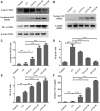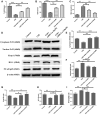Glycyl-L-histidyl-L-lysine-Cu2+ attenuates cigarette smoke-induced pulmonary emphysema and inflammation by reducing oxidative stress pathway
- PMID: 35936787
- PMCID: PMC9354777
- DOI: 10.3389/fmolb.2022.925700
Glycyl-L-histidyl-L-lysine-Cu2+ attenuates cigarette smoke-induced pulmonary emphysema and inflammation by reducing oxidative stress pathway
Abstract
Background: Chronic obstructive pulmonary disease (COPD) is a common respiratory disorder manifested as chronic airway inflammation and persistent airflow limitation with the essential mechanism as inflammatory response and oxidative stress induced by toxic exposures such as cigarette smoke (CS). Glycyl-L-histidyl-L-lysine (GHK) is a nontoxic tripeptide involved in the process of healing and regeneration as a natural product. With the combination of Cu(II), glycyl-L-histidyl-L-lysine-Cu2+ (GHK-Cu) improves antioxidative and anti-inflammatory bioavailability, and they might offer potential therapeutic properties for COPD. Thus, the present study aimed to identify the potential effects of GHK-Cu on emphysema induced by cigarette smoke. Methods: In the in vivo experiment, C57BL/6J mice were exposed to CS for 12 weeks to induce pulmonary emphysema. GHK-Cu was injected intraperitoneally at doses of 0.2, 2 and 20 μg/g/day in 100 µl of saline on alternative days from the 1st day after CS exposure. The effects of GHK-Cu on the morphology of CS-induced emphysema, the inflammatory response and oxidative stress were evaluated. The antioxidative effect of GHK-Cu on human alveolar epithelial A549 cells was assessed in vitro. Results: GHK-Cu treatment attenuated the CS-induced emphysematous changes and partially reversed the matrix metalloprotein -9 (MMP-9)/tissue inhibitor of metalloproteinases-1 (TIMP-1) imbalance in the lung tissue. GHK-Cu reduced the inflammation and oxidation by decreasing the expression of inflammatory cytokines (IL-1β and TNF-α) in the bronchoalveolar lavage and the enzymatic activity of MPO and MDA in the lung homogenate while restoring the T-AOC and GSH content. Furthermore, administration of GHK-Cu reversed the increase in NF-κB expression induced by CS and increased the Nrf2 level, as an antioxidant defense component, in mice with chronic CS exposure. In CSE-exposed human alveolar epithelial A549 cells, GHK-Cu also inhibited oxidative stress by suppressing MDA levels and restoring T-AOC and GSH levels, which were modulated by upregulating Nrf2 expression. Conclusion: GHK-Cu treatment attenuated CS-induced emphysema by anti-inflammation by downregulating NF-κB and antioxidation via upregulation of the Nrf2/Keap1 in lung tissues.
Keywords: GHK-Cu; NF-κB; Nrf2; cigarette smoke; emphysema; inflammation; oxidative stress.
Copyright © 2022 Zhang, Yan, Lu and Zhou.
Conflict of interest statement
The authors declare that the research was conducted in the absence of any commercial or financial relationships that could be construed as a potential conflict of interest.
Figures






Similar articles
-
Glycyl-l-histidyl-l-lysine-Cu2+ rescues cigarette smoking-induced skeletal muscle dysfunction via a sirtuin 1-dependent pathway.J Cachexia Sarcopenia Muscle. 2023 Jun;14(3):1365-1380. doi: 10.1002/jcsm.13213. Epub 2023 Mar 10. J Cachexia Sarcopenia Muscle. 2023. PMID: 36905132 Free PMC article.
-
Protective effects of GHK-Cu in bleomycin-induced pulmonary fibrosis via anti-oxidative stress and anti-inflammation pathways.Life Sci. 2020 Jan 15;241:117139. doi: 10.1016/j.lfs.2019.117139. Epub 2019 Dec 4. Life Sci. 2020. PMID: 31809714
-
Aurintricarboxylic acid mitigates cigarette smoke extract induced oxidative stress and pulmonary inflammation via inhibition of NF-ҡB/p65 signaling.Toxicol Mech Methods. 2023 Jan;33(1):83-94. doi: 10.1080/15376516.2022.2090302. Epub 2022 Jul 4. Toxicol Mech Methods. 2023. PMID: 35706141
-
Are We Ready to Measure Skin Permeation of Modern Antiaging GHK-Cu Tripeptide Encapsulated in Liposomes?Molecules. 2025 Jan 1;30(1):136. doi: 10.3390/molecules30010136. Molecules. 2025. PMID: 39795193 Free PMC article. Review.
-
Cigarette Smoke-Induced Respiratory Response: Insights into Cellular Processes and Biomarkers.Antioxidants (Basel). 2023 Jun 3;12(6):1210. doi: 10.3390/antiox12061210. Antioxidants (Basel). 2023. PMID: 37371940 Free PMC article. Review.
Cited by
-
Exploring the beneficial effects of GHK-Cu on an experimental model of colitis and the underlying mechanisms.Front Pharmacol. 2025 Jul 2;16:1551843. doi: 10.3389/fphar.2025.1551843. eCollection 2025. Front Pharmacol. 2025. PMID: 40672369 Free PMC article.
-
The TIMP protein family: diverse roles in pathophysiology.Am J Physiol Cell Physiol. 2024 Mar 1;326(3):C917-C934. doi: 10.1152/ajpcell.00699.2023. Epub 2024 Jan 29. Am J Physiol Cell Physiol. 2024. PMID: 38284123 Free PMC article. Review.
-
Protective Effect of the Total Alkaloid Extract from Bulbus Fritillariae pallidiflorae in a Mouse Model of Cigarette Smoke-Induced Chronic Obstructive Pulmonary Disease.Int J Chron Obstruct Pulmon Dis. 2024 Jun 10;19:1273-1289. doi: 10.2147/COPD.S459166. eCollection 2024. Int J Chron Obstruct Pulmon Dis. 2024. PMID: 38881716 Free PMC article.
-
Synergistic Antioxidant and Anti-Inflammatory Effects of Phenolic Acid-Conjugated Glutamine-Histidine-Glycine-Valine (QHGV) Peptides Derived from Oysters (Crassostrea talienwhanensis).Antioxidants (Basel). 2024 Apr 10;13(4):447. doi: 10.3390/antiox13040447. Antioxidants (Basel). 2024. PMID: 38671896 Free PMC article.
References
LinkOut - more resources
Full Text Sources
Research Materials
Miscellaneous

